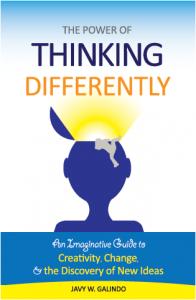Excerpt The Science of Lateral Thinking, a research paper by Javy W. Galindo
—
We now know that our brains have the capability to restructure its neural networks and firings patterns. Research has not only demonstrated the brain’s inherent plasticity, but it seems to indicate that the brain has evolved a specific division of labor that allows us to grow, learn, adapt, carry multiple meanings, and hold various perspectives. Hence, we need not be slaves to our predominant thought processes and patterns, for we have an inherent capability for lateral thinking, if not a propensity for it.
Still, in order to change our more common thought processes we must be able to access new insights that provide the impetus and inspiration for new patterns. Through these creative ideas we can begin to recognize different associations and lessen the strength of connectivity between old ones. It is this type of thinking that can help us deal with open-ended scenarios such as the following two examples:
Scenario 1: A moneylender said he would cancel farmer John’s debt if he could have John’s daughter instead. So he told the farmer that he would put a black pebble and a white pebble into an empty bag and that the farmer’s daughter would have to pick out one of the pebbles. If she chose the black pebble she would become his wife and John’s debt would be cancelled. If she chose the white pebble she would stay with farmer John and the debt would still be cancelled. But if she refused to pick out a pebble John would be thrown into jail and she would starve. Farmer John agreed. The moneylender stooped down to pick up the two pebbles from the pebble filled ground. As he picked up the pebbles the girl noticed that he picked up two black pebbles and put them into the moneybag. He then asked the girl to pick out the pebble that was to decide her fate and that of her father. What should she do?
Scenario 2: There are a carrot, a pile of pebbles, and a pipe lying together in the middle of a field. Why?
Scenarios such as these are more akin to the types of decisions and problem we encounter in everyday life. They call for optimal solutions and not absolute, calculable answers. They require us to reinterpret our initial perceptions of the scenario, and of what is possible, through the use of our creative faculties. The solutions also often occur as flashes of insight. So far, there has been relatively little neuroscientific examination of creative thought and the aha experience that can accompany it. Many in the field consider this type of investigation as being “over the edge” (Andreasen, 2005, p. 70). Nevertheless, research pertaining to the association cortex, the right cerebral hemisphere, computer creativity, and stress all provide a window with which we can better understand the mechanism of creative insight and provide clues on how we can develop it as a skill.
—
Please leave comments, questions, and suggestions below.


